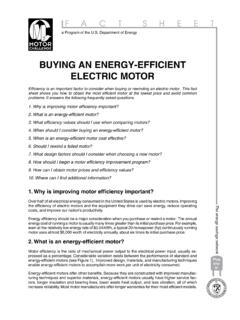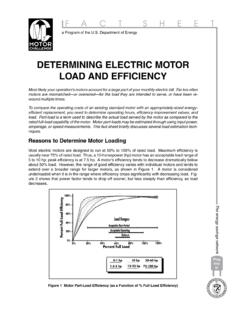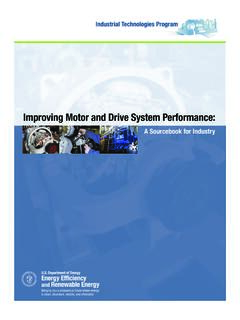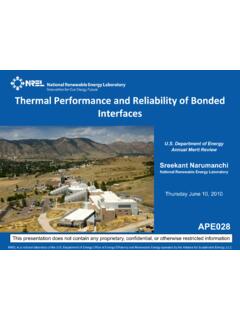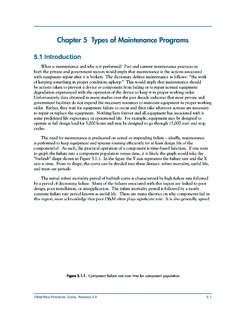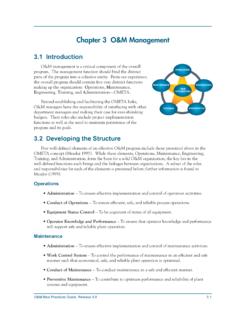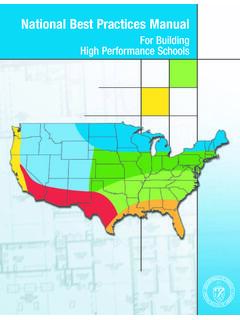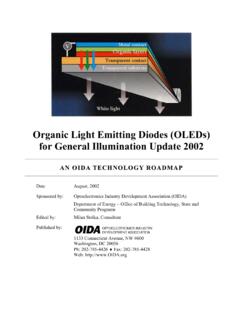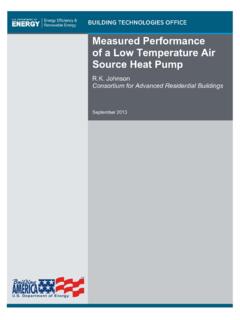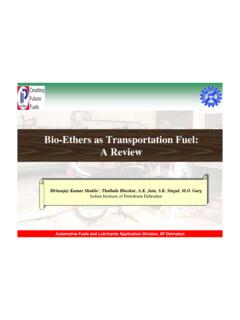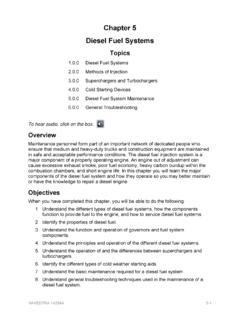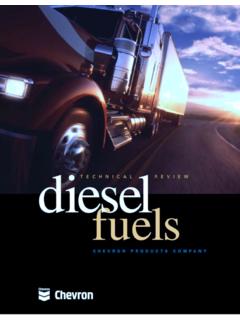Transcription of Liquid Fuel Reformer Development: Autothermal Reforming …
1 Liquid fuel Reformer development : Autothermal Reforming of diesel fuel C. Pereira, J-M Bae, S. Ahmed,and M. KrumpeltElectrochemical Technology ProgramChemical Technology Division Argonne National Laboratory9700 S. Cass Avenue Argonne, Illinois 60439 Presented at Department of Energy2000 Hydrogen Program Technical ReviewSan Ramon, CaliforniaMay 9, 2000 The submitted manuscript has been createdby the University of Chicago as Operator ofArgonne National Laboratory ("Argonne")under Contract No. W-31-109-ENG-38 withthe Department of Energy. The retains to itself, and others actingon its behalf, a paid-up, nonexclusive, irrevocableworldwide license in said article to reproduce,prepare derivative works, distribute copies to thepublic, and perform publicly and displaypublicly, by or on behalf of the Government. Work supported by the Department of Energy and Office of HydrogenTechnology, under Contract fuel Reformer development : Autothermal Reforming OF diesel FUELC.
2 Pereira , J-M. Bae, S. Ahmed, and M. KrumpeltArgonne National LaboratoryChemical Technology DivisionArgonne, IL 60439 AbstractArgonne National Laboratory is developing a process to convert hydrocarbon fuels toclean hydrogen feeds for a polymer electrolyte fuel cell. The process incorporates anautothermal Reforming catalyst that can process hydrocarbon feeds at lower temperaturesthan existing commercial catalysts. We have tested the catalyst with three diesel -typefuels: hexadecane, certified low-sulfur grade 1 diesel , and a standard grade 2 yielded products containing 60% hydrogen on a dry, nitrogen-free basis at850 C, while maximum hydrogen product yields for the two diesel fuels were near 50%.Residual products in all cases included CO, CO2, ethane, and methane. Further studieswith grade 1 diesel showed improved conversion as the water: fuel ratio was increasedfrom 1 to 2 at 850 C.
3 Soot formation was reduced when the oxygen:carbon ratio wasmaintained at 1 at 850 C. There were no significant changes in hydrogen yield as thespace velocity and the oxygen: fuel ratio were varied. Tests with a microchannelmonolithic catalyst yielded similar or improved hydrogen levels at higher space velocitiesthan with extruded pellets in a packed Department of Energy's Hydrogen Program is sponsoring the development of remotepower generation in the Arctic circle. Because the fuel available is diesel , the traditionalmeans of power generation in these remote locations has been internal combustionengines. Recent developments in fuel cell power systems, which are more efficient andproduce cleaner emissions, suggest that these systems, if adapted to operate with dieselfuels, can be used in the Arctic. Since fuel cells operate on hydrogen, the operation offuel cells with a diesel feed requires that the fuel be efficiently converted into ahydrogen-rich, sulfur-free the chemical process industries, hydrogen is produced in large quantity by the steamreforming process where the hydrocarbon fuel , typically methane, is reacted withsteam.
4 Because this reaction is endothermic, an efficient heat exchanger is required totransfer heat from another source, such as a fuel burner, to the Reformer . Consequently,steam Reforming is best suited for large chemical plants, which normally have excess heatavailable from other processes. At a smaller scale, an attractive alternative is autothermalreforming, where the hydrocarbon fuel is reacted with both air and steam to producehydrogen. The heat generated by this reaction can be controlled directly by adjusting theproportions of fuel , air, and steam in the feed. With an appropriate feed, external heat isnot required, making Autothermal reformers simpler, smaller, and lighter than steamreformers. Autothermal Reforming in the petrochemical industry is typically done in atwo-step process a high-temperature (1200 C) step where the complex hydrocarbonsare broken down into simpler molecules (methane and oxides of carbon), followed by(catalytic) steam Reforming of Argonne National Laboratory, we are developing a process to convert hydrocarbonfuels to clean hydrogen feeds for polymer electrolyte fuel cells (PEFC).
5 The processincorporates an Autothermal Reforming catalyst that can process hydrocarbon feeds atlower temperatures than existing commercial catalysts. We have developed anautothermal Reforming catalyst that converts gasoline to hydrogen, carbon monoxide, andcarbon dioxide at temperatures as low as 650-900 C. We have also demonstratedcomplete conversion of these feeds, producing enough hydrogen to power a 5-kW fuelcell stack (Ahmed, 1998).The effluent from the Reformer requires further treatment before it can be fed to a PEFC stack. Carbon monoxide and sulfur poison the fuel cell electrodes when present above afew parts per million. To address this problem Argonne National Laboratory isoptimizing sulfur scrubbers for compact systems like Autothermal reformers , developingmore robust water-gas shift catalysts that will work better under transient operatingconditions than current catalysts (Kumar, 1999), and testing catalysts for preferentialoxidation of CO and CO sorbents to treat the product diesel fuel requires that several problems be overcome.
6 These problems arerelated to degradation of catalysts over time because of the nature of the fuel . Causes ofdegradation include poisoning of catalysts by sulfur; diesel typically has a higher fractionof sulfur than other fuels. Thermal cycling, particularly on startup and shutdown, leads tothermal shock. Because of the low H:C ratio and high molecular weight of diesel ,extensive coke formation deactivates catalysts. High temperatures improve conversion,resulting in better system efficiency, but reduce material a previous paper (Pereira, 1999) we reported preliminary results on autothermalreforming of three fuels: hexadecane, grade 1 diesel , and grade 2 diesel . This paperreports the effect of operating conditions on the performance of the catalyst and onreforming of the diesel fuel . Results of diesel Reforming over a new monolithicmicrochannel catalyst show improved conversion at higher fuel throughputs.
7 Finally,results of fuel tests run with Reformer in tandem with water-gas shift reactors showreduction of carbon monoxide to less than 2%. These results show that autothermalreforming appears promising as an alternative to steam Reforming for remote applications,and that Argonne's Autothermal Reforming catalyst shows superior low-sulfur diesel fuel , grade no. 1, was obtained from Phillips Petroleum diesel fuel , grade no. 2, was obtained from a local service station (nomenclatureaccording to ASTM D975-97). The fuels were not treated further; fuel properties areprovided in the previous report (Pereira, 1999). The Autothermal catalyst was prepared in-house as extrudates and in a monolithic form. The catalyst was placed in a cm IDtubular reactor within a tube furnace. The bed height was approximately cm for theextrudates, and either 1 or 2 cm for the monolith.
8 The temperatures at the top and bottomof the bed were monitored with thermocouples. Water-gas shift catalysts were fabricatedas extrudates. Commercial zinc oxide and iron-chromium oxide catalysts were obtainedfrom United Catalysts, Inc., for sulfur removal and high temperature shift, fuel and water were fed at the top of the reactor, where they were vaporized andmixed with the incoming oxygen and nitrogen; the nitrogen was used as an internalstandard. The Liquid feed rates were controlled with high pressure Liquid chromatography(HPLC) pumps; the gas flow rates were maintained with mass flow controllers. Thereactant stream was passed over the catalyst, and the products analyzed with a gaschromatograph. Pure oxygen was used in the reactant stream to improve detection of anyhydrocarbons that may be present in the product. The gas chromatograph (GC) could notbe used to quantify water and heavy hydrocarbons.
9 Therefore, we used the hydrogen-to-carbon (H/C) ratio to obtain an atom balance and approximate a mass balance. In additionto the GC, an infrared detector was used to continuously measure the CO concentration inthe effluent from the water-gas shift and DiscussionCompositional AnalysisIn previous feasibility studies, hexadecane (C16H34) was used as a surrogate fordiesel fuel (Pereira, 1999). The initial operating conditions used for diesel fuel were setbased on the results obtained for hexadecane. In this study, we have refined our operatingconditions based on a more detailed analysis of the composition of diesel fuel in order todetermine suitable operating conditions for the ANL catalyst. We examined more closelythe composition of the two diesel fuels that were used in our tests with the autothermalreforming catalyst. The two fuels were a certified low-sulfur grade 1 fuel and a standardgrade 2 fuel obtained from the ANL motor-pool.
10 The two fuels were analyzed by twoanalytical methods. The analysis of the certified diesel used in the microreactor testsdescribed in this report is discussed of the complex nature of diesel fuel (several hundred separate components havebeen identified), a complete chemical breakdown of the fuel was not feasible. However,we have obtained elemental and compositional data based on chemical structure. Usingthis breakdown and assigning a reference compound for each grouping, we obtained an"average" chemical composition to further refine the operating parameters for the analysis is shown in Table 3 for the certified fuel . The elemental compositionderived from this analysis matches the measured elemental composition well. Theseresults were used to set the ranges of oxygen and water feed 3: Compositional analysis of certified grade 1 diesel fuelCompound CWt% % = not available, concentration of compound type is below detection on the results of the analyses, grade 1 diesel was determined to be significantlyricher in alkanes than the grade 2 diesel .
